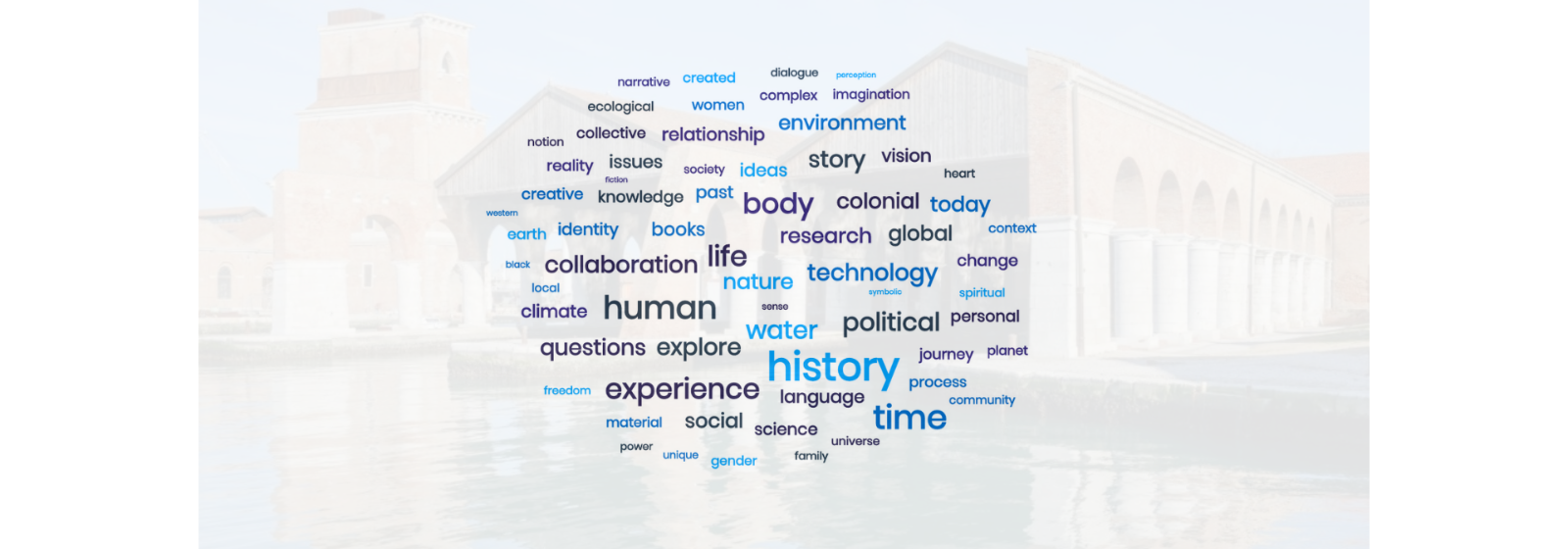To face the desires, ills, concerns or issues of our society head on in an event the likes of the Venice Biennale – the 59th edition of which will be held from 23 April to 27 November 2022 – and claiming to bring about change, does not make a lot of sense. It could even seem out of place, even though one may legitimately think that it is never pointless to (constantly) confront the elite with these issues. The art world can, however, be an appropriate arena for the expression of personal sensibilities. The words used for this purpose can therefore be seen as markers of an era - or perhaps that is giving them too much importance. You be the judge of that.
We have compiled almost all of the pavillion's text presentations in order to identify the words most frequently used:

History | 149 times
Time | 88 times
Human | 79 times
Life | 59 times
Body | 58 times
Experience | 57 times
Political | 45 times
Water | 45 times
Explore | 39 times
Collaboration | 39 times
Technology | 39 times
Story | 38 times
Questions | 34 times
Colonial | 33 times
Nature | 33 times
Global | 32 times
Research | 32 times
Today | 32 times
Environment | 30 times
Social | 30 times
Books | 26 times
Ideas | 25 times
Language | 25 times
Climate | 24 times
Vision | 24 times
Relationship | 24 times
Issues | 24 times
Past | 23 times
Identity | 22 times
Science | 22 times
Knowledge | 21 times
Change | 21 times
Personal | 21 times
Creative | 20 times
Reality | 20 times
Collective | 19 times
Journey | 19 times
Earth | 19 times
Process | 19 times
Women | 18 times
Material | 17 times
Complex | 17 times
Created | 17 times
Ecological | 16 times
Imagination | 16 times
Gender | 16 times
Planet | 16 times
Context | 16 times
Notion | 15 times
Narrative | 15 times
Spiritual | 15 times
Universe | 15 times
Heart | 15 times
Local | 15 times
Society | 15 times
Community | 15 times
Dialogue | 14 times
Freedom | 14 times
Family | 14 times
Unique | 13 times
Power | 13 times
Sense | 12 times
Black | 12 times
Western | 11 times
Symbolic | 10 times
Perception | 10 times
Fiction | 10 times
Here's our methodology: We had access to 72 texts dedicated to the presentation of national representatives, but also of the international exhibition as well as four participations dubbed "Collateral Events": Hong Kong, Catalonia, Palestine and Scotland + Venice. Reading all of these texts obviously does not allow us to deliver a factual analysis of any "line" within the proposals made for this 59th edition. The press releases detailing these exhibitions are not made following the same model, some are very detailed, others are more concise. Of the approximately 35,000 words analysed, pronouns, articles, prepositions, conjunctions, numbers and adverbs have been removed. Singulars and plurals were combined, while some words sharing a common root were combined. We have kept only the terms that appear in a minimum of 3 texts. Finally, we took the liberty of removing some of them, being too common or empty of meaning, to keep 67 in the end.
Considered pavilions: International Art Exhibition, Argentina, Armenia, Australia, Austria, Belgium, Brazil, Bulgaria, Cameroon, Canada, Chile, China, Croatia, Denmark, Estonia, Finland, France, Georgia, Germany, Ghana, Grand Duchy of Luxembourg, Great Britain, Greece, Grenada, Guatemala, Iceland, Ireland, Israel, Italy, Ivory Coast, Japan, Korea (Republic of), Kosovo, Kyrgyzstan, Latvia, Lebanon, Lithuania, Malta, Mexico, Mongolia, Montenegro, Namibia, Nepal, Netherlands, New Zealand, Nordic Countries (Norway-Sweden-Finland), North Macedonia, Philippines, Poland, Portugal, Romania, San Marino, Saudi Arabia, Serbia, Singapore, Slovenia, South Africa, Spain, Switzerland, Turkey, Uganda, Ukraine, United Arab Emirates, United States of America, Uruguay, Uzbekistan, Venezuela, Zimbabwe, Hong Kong, Catalonia, Palestine and Scotland + Venice.









